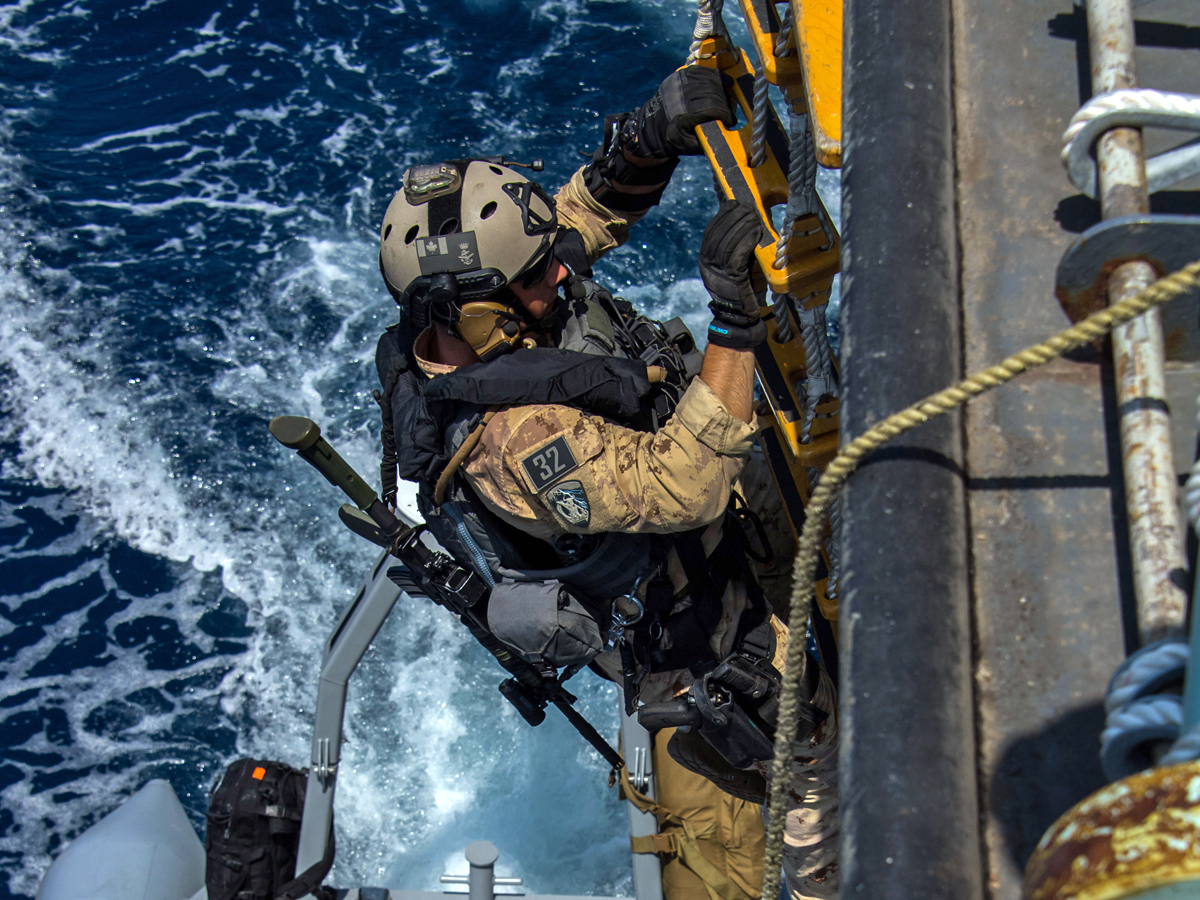A shift in boardings at sea training
By Lookout on Jan 30, 2020 with Comments 0

HMCS Regina’s Naval Tactical Operations Group prepares to board a Dhow during Operation Artemis in the Pacific Ocean on April 18. Photo by Corporal Stuart Evans, Borden Imaging Services
LCdr Mike Erwin, NFS(P) ~
A change took place in the delivery of Naval Boarding Party (NBP) training in October when Naval Fleet School (Pacific) turned over responsibility to the Naval Tactical Operations Group.
The turnover was part of an overarching direction that would see all matters concerned with naval boarding fall increasingly under Naval Tactical Operations Group’s purview.
As the cutlass was passed from one organization to the other, it marked the end of a decades-long era in which the Fleet School, first as Canadian Forces Fleet School (Esquimalt) and then as Naval Fleet School (Pacific), trained individuals and ship’s teams in the conduct of boardings at sea in support of maritime interdiction operations.
About Naval Boardings
The requirement to board ships is as old as navies themselves.
Whether it was to inspect a vessel in support of a naval blockade or to overpower an enemy ship and take it as a prize, warships have always needed to insert teams of personnel into other ships. Literature and film are rife with images of ships bearing down upon one another, as boarding parties swarm over the side and through the rigging to the stirring cry of “Out cutlasses and board!”
The Royal Canadian Navy is no exception.
One of Canada’s most famous boardings took place in the Caribbean during the Second World War. German U-Boat U-94 had been damaged by United States Navy aircraft, as well as depth charges and gunfire from the Canadian corvette HMCS Oakville.
As the commanding office of Oakville brought his ship alongside the stricken enemy, only SLt Hal Lawrence and PO Art Powell were able to leap onto the sub’s deck before Oakville lost power and drifted further away.
In jumping from the ship to the U-Boat, SLt Lawrence’s belt snapped and he lost the shorts he’d been wearing, and wound up taking the submarine clad only in a lifebelt, flashlight, two grenades, and pistol. He and PO Powell were able to clear the boat of its crew before it sank. For their part in that heroic, if somewhat an unconventional boarding, SLt Lawrence and PO Powell were awarded the Distinguished Service Cross and Distinguished Service Medal respectively.
Boarding in the 1990s
Following Iraq’s invasion of Kuwait in 1990, the UN passed Security Council Resolutions to enforce an embargo on Iraq, and Canada sent a task group consisting of HMC Ships Terra Nova, Athabaskan, and Protecteur to be part of a 35-nation coalition in the First Gulf War.
The Canadian Task Group, with five Sea King helicopters embarked, sailed from Halifax on August 24 and commenced operations in the Arabian Gulf on October 1. By the end of the war, Canada had conducted more than a quarter of all coalition boardings.
Maritime interdiction operations
Since then, Canada has maintained a presence in the Arabian Sea and Gulf, the Mediterranean Sea, and at times the Red Sea and the Black Sea, throughout a series of named operations a main focus of which has been maritime interdiction operations. The largest of these was Op Apollo (2001-2003), in which all but one of the RCN’s frigates, both auxiliary oil replenishers, and a destroyer deployed, and Canada commanded the multi-national task force responsible for the Gulf of Oman.
The evolution of boardings
Throughout the decades, tactics and equipment involved in naval boardings evolved, and so too did the training.
The school’s Naval Boarding Party Cell, sited at Work Point, eventually included a mock-up of a ship complete with sea containers for inspections, a separate Kill House for training with small arms loaded with simulated ammunition, a large matted area for close quarter combat training, a gym, and classroom and office spaces.
The six-week Basic Naval Boarding Party Course provided instruction in weapons handling, use of force, tactical search procedures, hazardous materials awareness, and the procedures involved in boarding and securing a ship.
The Naval Boarding Party Supervisor Course provided further training in the planning and execution of boarding operations, communications, intelligence gathering, shipboard documentation, and leadership.
The training was physically and mentally rigorous, but extremely rewarding, as successful completion meant the opportunity to serve as part of a ship’s boarding party and to participate personally in boarding operations while deployed.
The future of Naval Boarding operations and training will continue to change in interesting ways as naval architecture, weaponry, and tactics develop under the influence of evolving technologies. Come what may, the one common feature throughout the historical context of naval boarding is the sea, and the challenges it can throw at those who would operate in its unforgiving environs.
Naval Tactical Operations Group, with its unique operational expertise, is well positioned to provide this important training.
But as the Fleet School sheaths its cutlass and steps away from Naval Boarding Party training delivery, generations of Boatswains who oversaw countless course serials, and the scores of officers and sailors who received that training, can look back with well-founded pride at having provided the navy with a capability Canadian warships carried around the globe on deployed operations, and which was the envy of the world’s navies.
Filed Under: Top Stories
About the Author:





